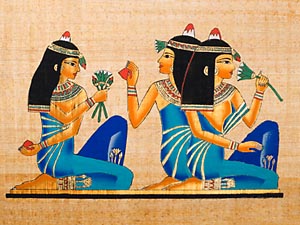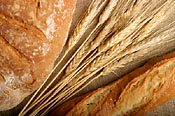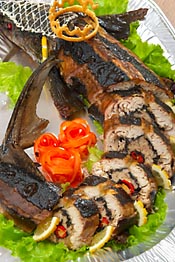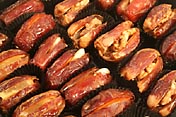How to Plan an Egyptian Feast
Samantha McNesby

The ancient Egyptians knew how to throw a party--which meant when they had a feast it was extravagant; bursting with food and celebration. Inscribed on the walls of Egyptian temples are images of great feasts that were usually carried out according to the pattern of the moon.
Start by selecting an occasion and feeling for your feast. Do you want to celebrate one of the actual Egyptian feast days of Wep-renpet or Wagy, or would you rather accentuate the food and culture of everyday Egyptian life? Learning a little bit about the things that the ancients celebrated can help you plan out your own feast. Two of the important Egyptian feast days are detailed below.
Feasts
- The Egyptians had feasts to mark New Year's Day (Wep-renpet) which held significant importance to the Egyptians not just because it was the beginning of a new year, but because it symbolized rejuvenation and rebirth.
- The Feast of Wagy was used to celebrate Osiris, and to connect with mortuary rituals; it is one of the oldest feasts in ancient Egypt. This feast is celebrated on the 17th day of each New Year. Due to changes in the calendar through the years, the date has bounced about a bit-the current date for Wagy is January 17th.
Food
The most important part of any feast? The food!
The river Nile and its fertile banks became the main source for most of the food in Egypt. Fishing and agriculture played a huge role in the Egyptian diet-and bread and fish were staples for many families. Most Egyptians could not afford the food we think of when we think "Egypt"-coconut, figs, and dates were enjoyed by the elite classes, and those of lower status did not often indulge.

Wheat Bread

Fried Sturgeon

Baked Sturgeon

Stuffed Dates
Planning an authentic feast today involves choosing some of the foods that were available to the ancients, and choosing cooking methods to match. Most food was prepared over an open flame, or in clay pots, so using a grill or clay cooking pot with a lid for food preparation will add authenticity to your meal.
Many of the foods enjoyed by Egyptians are available today:
- Bread: Egyptians enjoyed wheat bread as a dietary staple. Bread was prepared with, and served with honey. Pick up a rustic loaf of artisan wheat bread for your feast, and add a jar of local honey for an authentic taste of Egypt.
- Beer: The fertile soil deposited by the river Nile allowed the Egyptians to grow vast amounts of wheat-which they used to create both bread and beer. Surprisingly, beer was not considered a luxury item, it was available to all members of society, and a dietary staple at the time. For your Egyptian feast, select a few bottles of wheat-based beer from a microbrewery for the most authentic taste.
- Meat: Due to the Egyptian desert, raising pigs and cows was extremely difficult and therefore meats like pork and beef were rarely seen in Egyptian diets. Eggs and fish were the primary "meat" or animal protein sources enjoyed by the Egyptian people. Include a fish or egg dish as part of your feast-you can grill or fry either one.
- Vegetables: ever see a fat Egyptian? Not likely! The Egyptians loved their vegetables and so peas and beans feature regularly in old Egyptian recipes. Onions, garlic, leeks, lettuce, cabbages and turnips were also very popular with the Egyptians. Offer at least one vegetable, prepared by grilling or roasting, and seasoned with salt as a side dish. Don't want to cook? Offer a cabbage slaw or salad instead!
- Fruit: Fruit such as figs and dates were eaten in abundance by the Egyptians, who were also great fans of grapes, either to eat as a fruit or fermented into wine. Coconuts and olives were usually only eaten by the very wealthy.Fruit was an expensive luxury for those who could afford it-so for your feast, consider yourself to be a wealthy Egyptian, and stock up on the goodies. Offer bowls of fruit and olives or stuffed dates (recipe follows) as part of your meal.
Stuffed Dates
You will need pitted dates, shelled nuts, such as walnuts, pecans, chopped in any way you want, sugar or shredded coconut. Fill the dates with the nuts and cover in sugar or coconut for a real taste of Egypt.
Since meal preparation is more a gathering of items like bread, fruit, and honey (don't forget the beer!), you can spend some time creating a fun atmosphere for your feast. Gather any items you have that fit the theme, and use them to decorate the room where you will be serving the food. Egyptians used spoons-for applying kohl and makeup-they ate with their hands!
Look in a craft store for sheaves of wheat to use to decorate your table, and select rustic pottery and wood bowls for serving. If you would like, and have time, consider making a little chart or sign about each food item, and how it relates to Egyptian culture-or be prepared to tell your guests a bit about the food you are offering.
An Egyptian feast can be a fun event for adults, or a learning activity for families and children (minus the beer). Have fun with the planning and preparations, and enjoy eating like an Egyptian for a day!
Other Articles
© 2004-2021 Zarifa's Touch of Egypt
Licensed for publication by Samantha McNesby
- Shop Zarifa's |
- Belly Dance Costume & Accessories |
- Egyptian Decor |
- Workshops & Classes |
- Belly Dance Classes
- Affiliate Program |
- Check Out |
- Contact |
- Links |
- Business Policies |
- Home
Zarifa's Touch of Egypt · Boise, Idaho 83646 · Contact